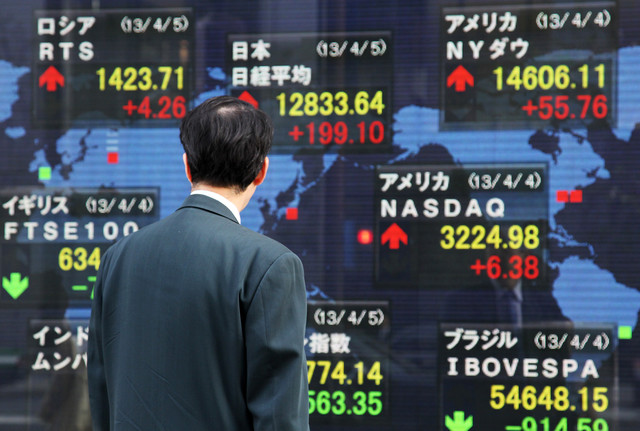
Stocks in Asia saw gains on Monday after Presidents Donald Trump and Xi Jinping agreed to a temporary trade truce between the United States and China.
The mainland Chinese markets, closely watched as a result of Beijing’s ongoing trade spat with Washington, saw strong gains on the day. The Shanghai composite gained 2.57 percent to close at around 2,654.80 while the Shenzhen composite advanced 3.275 percent to end the trading day at about 1,381.55.
The moves came following a new reading on economic activity in China, the Caixin Manufacturing Purchasing Managers’ Index, which showed factory activity grew slightly in November compared to the previous month.
The Caixin/Markit Manufacturing Purchasing Managers’ Index for November rose to 50.2 from 50.1 in October. Economists polled by Reuters had forecast a reading of 50.0, the level that separates expansion from contraction.
Meanwhile, Hong Kong’s Hang Seng index also jumped 2.5 percent as of the final hour of trade.
Japan’s Nikkei 225 rose 1 percent to close at 22,574.76 while the Topix index advanced 1.3 percent to end the trading day at 1,689.05. In South Korea, the Kospi gained 1.67 percent to close at 2,131.93.
Over in Australia, the ASX 200 jumped 1.84 percent to close at 5,771.20, with almost all sectors in positive territory. Shares of major miners saw strong gains: Rio Tinto advanced 2.33 percent, Fortescue Metals Group surged 4.25 percent while BHP Billiton gained 3.68 percent.
Trump and Xi hit pause
The moves in Asia came after Chinese President Xi Jinping and U.S. President Donald Trump agreed to a momentary pause on escalating the ongoing trade war between the two economic powerhouses.
“This is probably the best case scenario that markets were hoping for from the meeting of Trump and Xi and we’ve seen that anticipated ‘risk on’ rally this morning,” said Rakuten Securities Australia in a morning note.
They did, however, add that “analysts are already looking at the details and it doesn’t take long for doubts to come through on the strength of the agreement.”
“A simple look at the two press statements from either side shows some quite glaring differences of opinion and this could lead to a relatively short lived lift in investor confidence,” said the note.
A White House statement about the leaders’ dinner at the G-20 summit in Argentina said Xi and Trump discussed a range of nettlesome issues — among them the trade dispute that has left over $200 billion worth of goods hanging in the balance.
“President Trump has agreed that on January 1, 2019, he will leave the tariffs on $200 billion worth of product at the 10 percent rate, and not raise it to 25 percent at this time,” the statement read. Over the next 90 days, American and Chinese officials will continue to negotiate lingering disagreements on technology transfer, intellectual property and agriculture.
“The avoidance of a 25 percent tax is the good news, so that’s really what the markets (are) reacting to,” David Sokulsky, CEO and CIO of the Concentrated Leaders Fund, told CNBC’s “Street Signs” on Monday.
“The markets (have) been very concerned that these trade wars would escalate even more into a potential Cold War and what this does, it takes that significant risk, it doesn’t eliminate it, but it certainly reduces it,” Sokulsky said.
On the back of the developments between the U.S. and China, Dow Jones Industrial Average futures jumped 400 points shortly after the start of trading at 6 p.m. in New York on Sunday.
As of 2:07 a.m. ET Monday, futures pointed to an implied gain of 477.54 at the open for the Dow.
Oil prices surge after November slump
Oil prices saw strong gains Monday afternoon during Asian trading hours, but pared some of their earlier gains on the back of Qatar announcing its plans to pull out of OPEC days before an anticipated meeting between the cartel and its allies. The international benchmark Brent surged 4.42 percent to $62.09 per barrel. U.S. crude futures leaped 4.81 percent to $53.38 per barrel after earlier seeing gains of more than 5 percent.
The crude markets saw their worst month in a decade during November, amid concerns of oversupply and global politics.
West Texas Intermediate, or U.S. crude, lost 21 percent in November, tumbling to its lowest level in a year and logging its worst performance since October 2008.
Currencies
The U.S. dollar index, which tracks the greenback against a basket of its peers, was at 96.785 after touching highs above 97.5 last week.
Joseph Capurso, a currency strategist at Commonwealth Bank of Australia, said in a morning note that the U.S. dollar could “fall further over the next day or two” in reaction to the meeting between Xi and Trump.
“But we are not optimistic of a speedy resolution of their trade frictions. China is unlikely to do more than tweak its ‘Made in China 2025’ plan that so irks the US government,” he wrote.
The Japanese yen, widely seen as a safe-haven currency, was at 113.50 against the dollar after touching highs around the 112.9 handle in the previous trading week. The Australian dollar traded at $0.7375 after hitting lows around $0.72 last week.





























